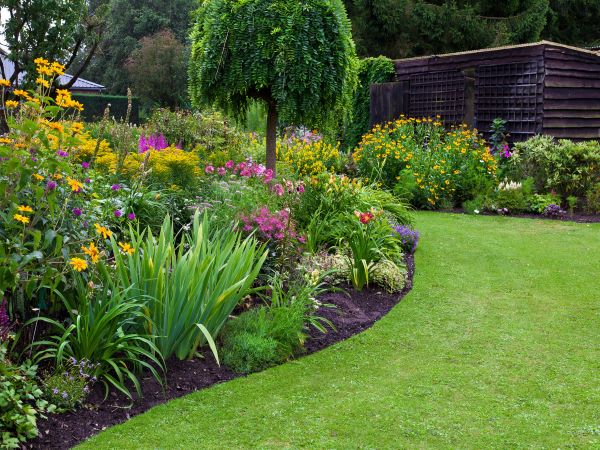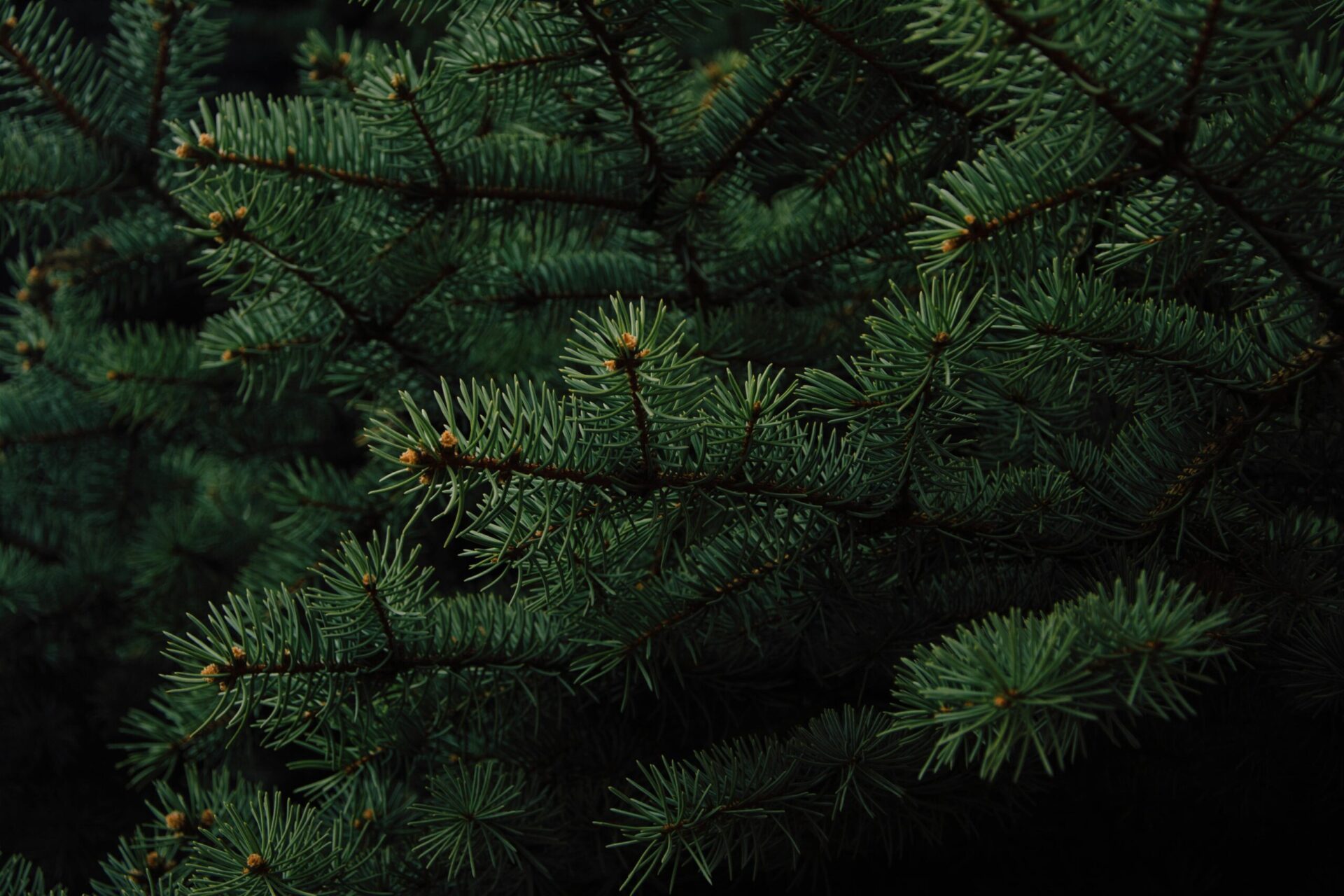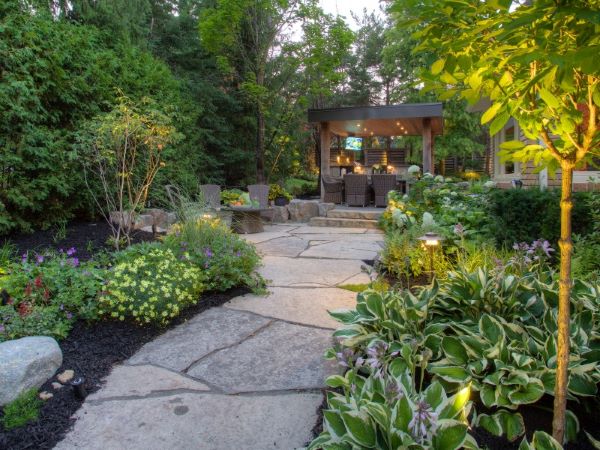When planning a landscaping project for your Vancouver home, it’s essential to understand the difference between softscaping and hardscaping. These two components work together to create a balanced, aesthetically pleasing outdoor space. Each plays a unique role and requires different materials, skills, and maintenance. This blog post will delve into the definitions, examples, and considerations of both softscaping and hardscaping, helping you make informed decisions for your landscaping needs.

What is Softscaping?
Softscaping, also known as soft landscaping, refers to the use of living plant materials such as trees, shrubs, hedges, grass, and other ground covers. It also includes the modification of the landform, such as by berming and terracing. Essentially, anything that grows and changes over time as part of the garden’s natural cycle falls under softscaping.
Examples of Softscaping
- Plants and Flowers: These add color, fragrance, and variety to your garden. They can be annuals, perennials, or biennials.
- Trees and Shrubs: These provide structure, shade, and privacy. They can also serve as windbreaks or noise barriers.
- Grass and Ground Cover: These create lush, green spaces for relaxation and play. Ground covers like moss or creeping thyme can fill in gaps and prevent soil erosion.
- Soil and Mulch: Quality soil is the foundation of a healthy garden, while mulch helps retain moisture and suppress weeds.
- Garden Beds and Borders: These define different areas of your garden and can be designed with various plant types to create visual interest.
The Purpose of Softscaping
Softscaping serves multiple purposes in a landscape, particularly for homeowners looking to enhance their outdoor living spaces. It introduces life, color, and texture to a garden, creating a dynamic and visually appealing environment that changes with the seasons. Softscaping can significantly improve the curb appeal of a home, making it more inviting and attractive. Additionally, it contributes to a serene and tranquil garden atmosphere, perfect for relaxation and outdoor activities.
From an environmental perspective, softscaping plays a crucial role in supporting local ecosystems. It provides habitats for wildlife, such as birds and pollinators, and contributes to improved air quality. Furthermore, plants can help manage water runoff and reduce soil erosion, making softscaping an essential element of sustainable garden design.

What is Hardscaping?
Hardscaping refers to the non-living, structural elements of a landscape. This includes pathways, patios, retaining walls, and other built features that provide function and form to your outdoor space. Common materials used in hardscaping include stone, brick, concrete, wood, and metal.
Examples of Hardscaping
- Patios and Decks: These provide outdoor living spaces for dining, entertaining, and relaxing.
- Walkways and Pathways: These guide movement through the garden and can be made from materials like stone, brick, or gravel.
- Retaining Walls: These prevent soil erosion, manage slopes, and create defined garden areas.
- Water Features: Ponds, fountains, and waterfalls add a calming, aesthetic element and can attract wildlife.
- Fences and Gates: These provide privacy, security, and structure to your garden.
- Outdoor Lighting: Proper lighting enhances the functionality and safety of your outdoor spaces while highlighting landscape features.
- Pergolas and Gazebos: These structures offer shade and a focal point for outdoor gatherings.
The Purpose of Hardscaping
Hardscaping plays a crucial role in providing structure and functionality to an outdoor space. Its primary purpose is to create defined areas for various activities, such as dining, relaxing, or walking. For homeowners, hardscaping elements like patios and decks extend the living space of the home into the outdoors, creating ideal spots for social gatherings and family time. Walkways and pathways ensure safe and easy navigation through the garden, while retaining walls add depth and dimension to the landscape.
Hardscaping also contributes significantly to the value of a property. Well-designed hardscape features can enhance the overall aesthetic of the home, making it more appealing to potential buyers. Elements such as outdoor kitchens, fire pits, and water features can create luxurious and functional outdoor environments, adding to the home’s market value.
Integrating Softscaping and Hardscaping
For a cohesive and functional landscape, it’s important to integrate both softscaping and hardscaping elements. Here are some tips on how to achieve a balanced design:
- Plan Ahead: Start with a detailed landscape design that includes both softscaping and hardscaping elements. Consider how these components will interact and complement each other.
- Balance and Proportion: Ensure that your design maintains a balance between the soft and hard elements. Avoid overcrowding one type over the other.
- Complementary Materials: Use materials that complement the natural elements of your garden. For example, natural stone pathways can blend seamlessly with a lush garden bed.
- Functional Design: Think about the functionality of each element. For example, a patio should be easily accessible from the house and surrounded by plants that enhance the space’s ambiance.
- Seasonal Considerations: Choose plants that provide year-round interest and consider how hardscape elements will look in different seasons.
Softscaping and Hardscaping in Vancouver
Living in Vancouver offers unique opportunities and challenges for landscaping. The city’s mild, wet climate is perfect for a diverse range of plants, making softscaping a delight. However, the frequent rainfall also means that hardscaping elements need to be carefully chosen and installed to ensure durability and proper drainage.
When planning your Vancouver landscaping project, consider native plants that thrive in the local climate. Incorporating hardscape features like permeable pavers can help manage rainwater runoff and reduce erosion. Additionally, using quality soil and mulch will ensure that your plants remain healthy and vibrant throughout the year.
Conclusion
Understanding the difference between softscaping and hardscaping is crucial for creating a beautiful and functional landscape. Both elements bring unique benefits and, when integrated thoughtfully, can transform your outdoor space into an oasis. Whether you’re adding a new garden bed, installing a patio, or planning a complete landscape overhaul, a balance of softscaping and hardscaping will ensure your Vancouver home looks stunning year-round.
Latest
Making the Most of Winter 2025: Guide to Snow Removal and Cold-Weather Projects in Vancouver

The Definitive 2024 Vancouver Landscaping Tree Guide for Your Yard: A Guide to Selection, Care, and Pricing

Fall Landscaping Guide for Vancouver in 2024: Maintenance, Hardscape and Softscape Transformations, and Winter Preparation

Thinking About Installing a Sport Court in Vancouver, BC? Here’s What You Need to Know

Vancouver Irrigation: The 6 Best Types for Your Garden

Looking to upgrade your outdoor space? Seymour Lawn and Garden is here to help. Our team of gardening experts specializes in crafting beautiful, sustainable landscapes that meet your specific needs. Contact us today, and let us transform your garden into a space you'll love all year round!




